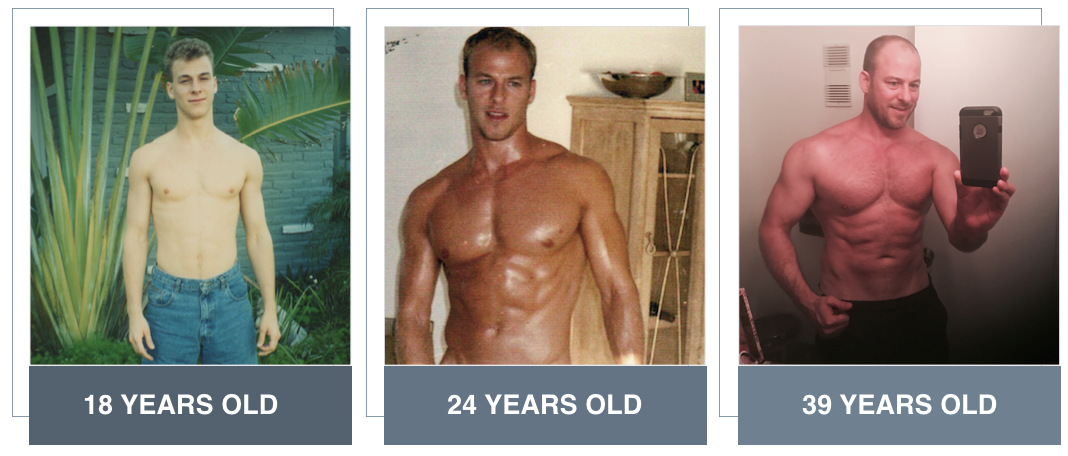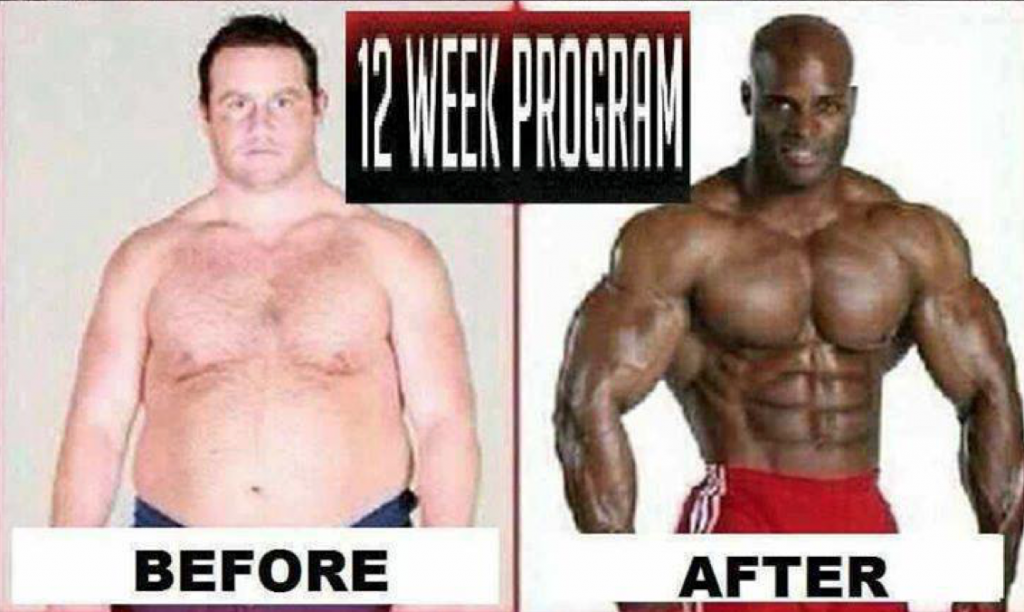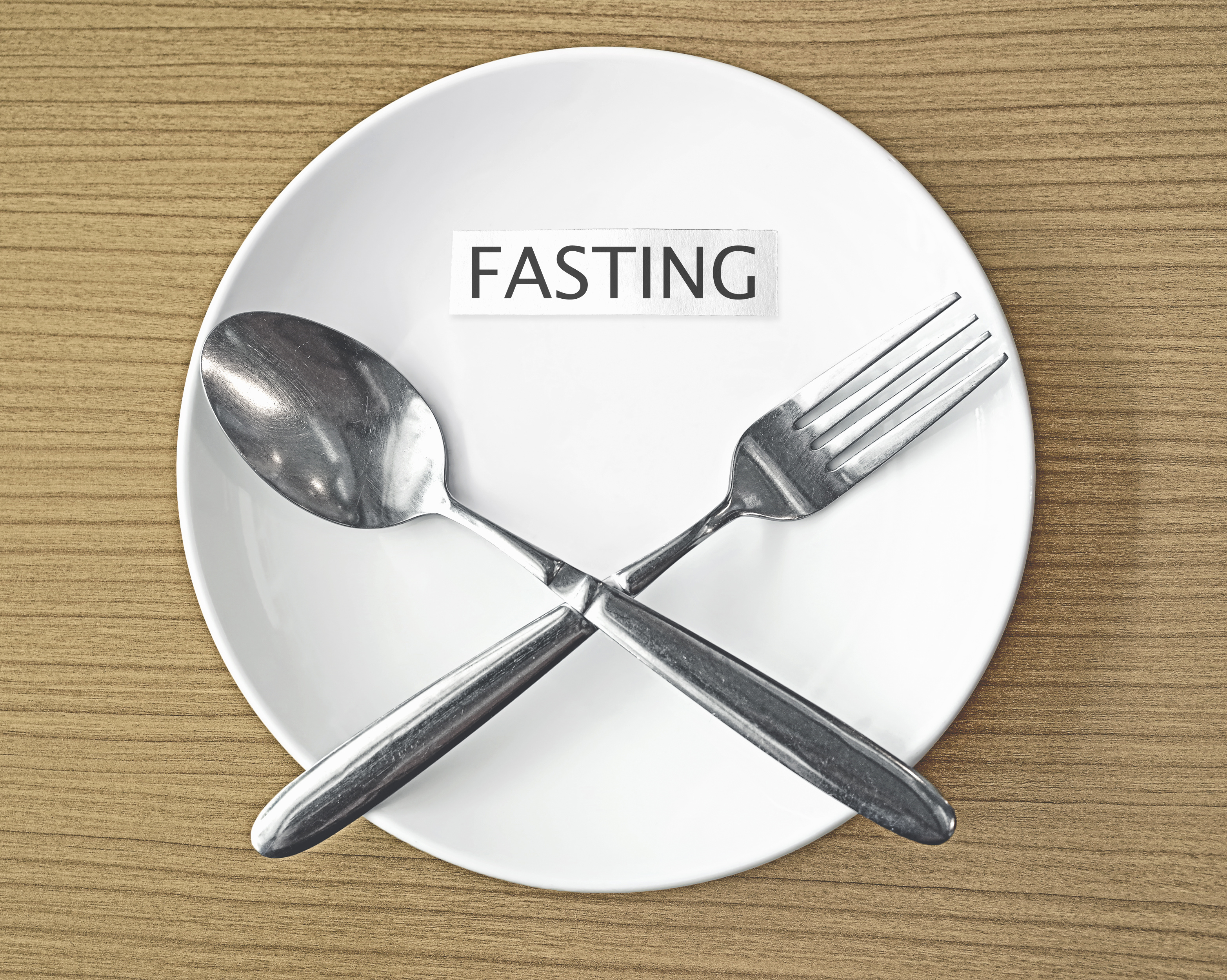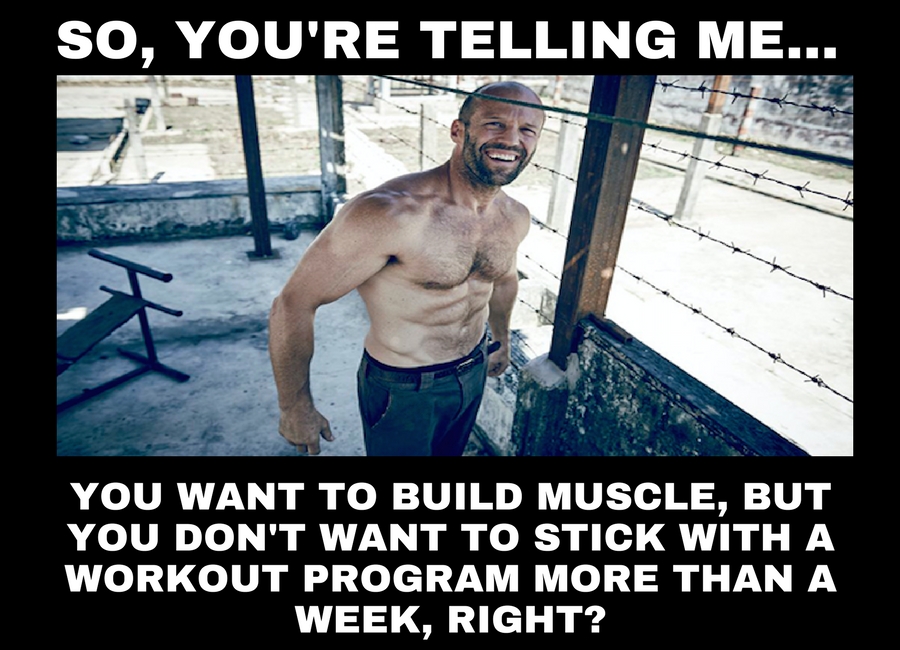Imagine this …
Each day you wake up, take your protein shake, exercise at the gym, and watch your body get bigger.
Could there be anything more satisfying than that?
Actually, yes. It’s much more satisfying (and rewarding) to …
… follow a diet for muscle growth and a muscle-building workout routine on a daily basis and watch your body transform and get stronger/huge.
I know a thing or two about getting bigger, leaner, and stronger, and I’m going to share my system with you now.
But before I do, you should know that you don’t need a crazy diet or insane workout program to start seeing amazing results in your body. You simply need a serious plan.
So, how do I know that?
My Story: A Journey Of Trial And (Predominantly) Error
I know because I’ve been there. I’ve tried the workouts in bodybuilding magazines. I’ve spent hundreds of dollars a month on supplements. I’ve spent endless hours looking for the “magic exercise” that would change my body. I’ve hopped from program to program, searching for that perfect system that would finally give me the strength and lean muscle gains I working so hard for.
None of it worked, and I was so frustrated. I blamed my genetics because that seemed like the only logical explanation for all my hard work not getting me results.
I Was On The Verge Of Giving Up
That is until I learned and followed the principles that I outline in this article. Then, I was able to transform my physique into something I was proud of.

NOTE: Get my Muscle Building Snack Guide and learn how to ignite muscle growth all day and stay lean with our 11 flavorful, protein-packed snacks. Just click here to grab your copy.
Are you ready to say bye-bye to the skinny guy?
Then let’s get started. In order to get the best results, you need to stop making these muscle-building mistakes.
In other words, ditch these habits, and you’ll finally start seeing those gains you’re working so hard for.
Here are seven of the biggest mistakes that I learned from my muscle building journey:

Habit #1: Not Being Patient
This is by far the most common problem I see in our modern world of instant gratification. Everyone wants a magic pill or shortcut to build muscle.
And there are plenty of companies who prey on that. You have probably seen advertisements online claiming to help you grow a ridiculous amount of muscle (5, 10, 20 pounds) in a single month.
This is virtually impossible — at least without steroids. In fact, the first month of weight lifting may yield a gain in muscle mass of almost zero.
How do I know?
A group of researchers from the University of Alabama-Birmingham recruited a few dozen people who hadn’t lifted weights in the past 5 years, then put them all on the same workout program for 16 weeks to see what would happen.
The results?
The researchers found that the study’s subjects fit into three categories:
- Extreme responders. These people got a whopping 50 percent increase in their thigh muscles in 16 weeks.
- Moderate responders. These people increased their thigh muscle size by 25 percent in 16 weeks.
- Low responders. These people’s thigh muscles didn’t grow at all in 16 weeks.
The researchers also found the results were predictable. The people who gained the most muscle mass started off with the most of something called microsatellite cells. Microsatellite cells help muscle fibers grow and repair. The more you have, the bigger you can grow. Some people have a lot. Most of us have a moderate amount. And, unfortunately, some of us are born with very little.
We could get into an in-depth discussion about the results of this study, but the main point I’m making is this:
If you’re a “hard-gainer” or someone who hits training plateaus quickly (that’s me, unfortunately) then you’re going to have to work more diligently than your fast-responding friends.
You’ll probably need a better program, better habits, and a longer time frame to get results.
Another important factor in building muscle has to do with your ”training age.”
Your training age is simply how long you’ve been training.
Why does this matter?
Beginners can get results more quickly than intermediate or experienced lifters. However, once you reach the intermediate and experienced levels of lifting, it takes a smarter approach to continue to build muscle. Here’s a great quote by muscle building nutrition guru Alan Aragon to give you some perspective:
“An entry-level lifter can gain 2 to 3 pounds of muscle mass in a month without adding much fat. An intermediate can gain 1 to 2 pounds a month, and an experienced lifter will be lucky to add a half-pound.”
– Alan Aragon
The above quote assumes that you’re doing everything more-or-less right, to begin with. I remember when I got on a serious lifting program when I was 16 and working out with the high school football team. My bench press and squat numbers skyrocketed in a matter of months! I was bench-pressing 225 pounds when I was previously struggling with 135 pounds. I was also getting more muscular even though I was working out less.
Although I had been working out for years (since I was 12 or 13) I hadn’t had any real structure to what I was doing. I’d go in and work hard by randomly moving from exercise to exercise and pushing myself to failure. But it wasn’t smart work, and I lacked the results for all my effort.
What to do instead:
Set realistic goals and know what to expect. Be ready to put in the work consistently to see the results you want. Take into account whether you respond quickly to workouts (you know who you are). If you don’t, then make sure you get onto a well-designed workout and nutrition plan. That’s why I designed my 90-day muscle-building workout and Muscle Building Nutrition Course.
Also, take into account your training age. If you’re just starting out, expect to see fast results. But if you’ve been lifting for a couple of years or more, then understand that you’re going to need a smarter approach and better methods to make consistent improvements.
So be patient, stay focused, and don’t quit!
Check out my muscle-building snack guide, where I share with you eleven snacks that you must try to get the results you want in just a few weeks. Click here to download now!

Habit #2: Skipping Your Sleep
I never cared about sleep in my early 20s.
I was always looking for a supplement or magic exercise that would make the difference.
But now I view sleep as a crucial part of the muscle-building process.
For starters, it’s hard to get to the gym and push yourself when you’re exhausted from staying up all night partying or binge-watching Netflix.
You’ve gotta have enough energy to push hard in the gym to build muscle.
Another important consideration is that sleep deprivation can actually impair your ability to build muscle and repair damage.
A 2011 study by Brazilian researchers found that skipping out on sleep decreases protein synthesis and increases protein breakdown, which will hinder muscle recovery from hard workouts as well as injury healing.
So inadequate and/or poor-quality sleep has a direct effect on your ability to build muscle and recover from your workouts.
Sleep deprivation also has a major effect on your testosterone levels.
Previous studies have shown that a gradual decrease in sleep time is partially responsible for low T in older men.
However, a 2011 study done at the University of Chicago reported the effect of one week of sleep restriction in healthy, young men.
The 10 young men in the study were recruited from around the University of Chicago campus. They passed a rigorous battery of tests to screen for endocrine or psychiatric disorders and sleep problems. They were an average of 24 years old, lean, and in good health.
After just one week of having their sleep restricted to five hours a night, their testosterone levels decreased by 10 to 15 percent. That means they had the testosterone levels of men who were 10 years older or more. Not. Good.
What all this means is that having poor quality sleep or failing to get enough sleep will impair your ability to build muscle, recover from exercise, and will lower your testosterone levels.
Not only is that a recipe for crappy results from all your hard work in the gym, but it’s also a recipe for poor health and a low sex drive.
This also means that focusing on sleep can be one of the most powerful tools in your muscle-building arsenal. And it’s free.
What to do instead:
I get into sleep in-depth in my Muscle Building Course, but I want to share with you some basics you can start today to get the potent anabolic effects of good quality sleep.
First, make sure you’re getting at least 7 hours of sleep every night. 8 or 9 hours is better if you’re training hard.
Average Americans say they get 6.8 hours of sleep a night, according to a 2013 Gallup poll, which is simply not enough. And they’re not working hard in the gym to build muscle. You’ll need more.
Second, practice sleep hygiene. You brush and floss to maintain proper oral hygiene or else you end up with a mouth full of cavities.
Sleep hygiene is a variety of different practices and habits that are necessary to have good nighttime sleep quality.
Without proper sleep hygiene, you may even get 8 hours of sleep but you will still feel sleepy because the 8 hours weren’t good quality sleep.
Here are some sleep hygiene basics:
- Go to bed and wake up at the same time.
- Dim your lights at night to avoid too much blue light (blue light suppresses melatonin production).
- Use blackout blinds in your bedroom to blackout all ambient light.
- Sleep on a quality bed that promotes proper support for your body.
- Cool your bedroom as lower temperatures will help you get into deep sleep more quickly.
That should get you started! If you want an in-depth education on how to get the best sleep possible, check out my Muscle Building Course and have a listen to my interviews with sleep experts:
(Related: The Power Of Sleep with Dr. Kirk Parsley)

Habit #3: Expecting Supplements To Do The Work
This is something I see all the time. And I used to be guilty of it as well.
You try to build muscle in the gym with some workout you found online.
It goes OK at first but then you hit a plateau. Instead of searching for the method of progression to help get past your training plateau, you start searching for the magic supplement that will make all your gains happen.
You try mass gainers, protein powders, pre-workouts, testosterone boosters, and more.
Maybe you get a little boost but you still aren’t able to make the consistent progress you want.
Told you I’ve been there.
A lot of people ask me about supplements and here’s what I say:
“My No. 1 piece of advice about supplements is that you don’t need them, most are a waste of time and money and some are even dangerous.”
What does work? It’s simple:
- Focus on your workouts.
Following the best workout program, you can find. This doesn’t mean another 4-week workout you found on Bodybuilding.com.
I’m talking about following a progressive workout that builds on itself every month. To give you an idea, I’ve written yearlong workouts for some clients. Every month is a progression from the previous month.
What does that mean?
No plateaus and consistent progress. That’s what good workout programming should do.
- Focus on nutrition.
Nutrition is the most common limiting factor I see with my clients who are looking to build muscle. It’s easy to get strong by training hard in the gym if you’re on a good workout program.
However, I promise you that you won’t make much progress with building lean muscle mass unless your nutrition is on point. And there isn’t a supplement in existence that will help you get around a poor nutrition program.
- Smart supplementation.
You may think that I’m against supplements from reading the past few paragraphs. I’m not.
In fact, I love supplements and would not have been able to make fast progress without them. But I only recommend five, which I go over in my Muscle Building Course.
But I want you to get information that you can use today so I’ll share with you the most powerful two supplements:
- Creatine monohydrate
Creatine monohydrate is the most researched sports performance supplement on the market. And it works for the majority of people who take it.
I’ve heard some people are non-responders (i.e. it doesn’t work for them) but I’ve never met one. Don’t waste your money with fancy creatines. Just buy 100 percent pure creatine monohydrate and take 5 to10 grams per day.
- Protein powder
Using protein powder is a very convenient way to make sure you’re maximizing protein synthesis (i.e. muscle building) without having to eat meals all the time.
We know the anabolic effects of a protein-rich meal last approximately 5 hours and that it’s better to have four or five of these meals (instead of three or fewer), so having a quick protein shake can be a great way of getting in your protein.
Whey is the best choice because of its high leucine (the most important nutrient for building muscle) content.
I’m not convinced that plant-based protein powders are worth your time because of the lack of leucine, but they may help those people on plant-based diets get enough protein without the added carbohydrates or fat that come with most plant-based sources of protein.
What to do instead:
Spend your time and money on dialing in your workout program and nutrition.
If you have some extra money to spend on supplements, then consider a whey protein and a 100 percent pure creatine monohydrate supplement.
(Related: 6 Best Supplements For Building Muscle, Sleep, Stress, And Better Health with Ted Ryce)

Habit #4: Working Out On An Empty Stomach
With intermittent fasting being so popular at the moment, this idea of fasted training is even more important to address.
While there’s some evidence that intermittent fasting may help you lose fat, it’s a terrible approach to building muscle.
Even if you aren’t on the intermittent fasting bandwagon, you may be one of those people who work out first thing in the morning before breakfast.
Either way fasted training (where you haven’t eaten in 3 or more hours) is not ideal when it comes to building muscle.
A 2013 meta-analysis in the Journal of the International Society of Sports Nutrition found that having enough protein pre-workout is just as critical to muscle building as downing your protein shake after your workout — especially if you haven’t had a protein-rich meal 3 or more hours before your workout.
What to do instead:
Having a 25-to-30-gram serving of high-quality protein before and after exercising is a simple, science-backed guideline that will help you maximize the anabolic response to your workout.
While you can certainly eat whole foods, I highly recommend a whey protein powder for convenience and for avoiding the stomach discomfort that might occur during a hard workout if you eat a whole food meal.
NOTE: If you want to eat the right snacks that will help you grow muscle all day and stay lean, just click here to grab your free copy.

Habit #5: Not Eating Frequently Enough
I hear the same thing from my clients over and over …
“Ted, I know eating is important, but can I just eat two times per day and double my protein intake to get the same results?”
The short answer is no.
Logically, it makes sense. If you need to eat a certain amount of protein during the day, why not just simplify your life and eat two big, protein-rich meals? Except that your body runs by the rules of biology, not logic.
Research by McMaster University’s Dr. Stuart Phillips and others has found that if you eat more than 20 to 30 grams of protein at a time, you don’t get any further anabolic boost. Any extra protein is simply burned for energy; unlike carbohydrates or fat, you can’t save it for later.
Dr. Stuart Phillips also tested three different ways of taking in 80 grams of protein in one day: eight equally spaced doses of 10 grams; four doses of 20 grams; or two doses of 40 grams.
The four doses of 20 grams produced the best results.
You can eat all the protein you want, but unless you distribute it appropriately, you can still fall well below your body’s needs for maximizing muscle growth.
In another exciting find, a study published by researchers in the Netherlands showed that a dose of protein immediately before bed kept the body in an anabolic state overnight, boosting overall protein synthesis rates by 22 percent.
What to do instead:
Forget intermittent fasting and eating two to three times per day if building muscle and performance is your priority. Instead, shoot for four meals per day that contain about 20 to 30 grams of protein. And for a muscle-building boost and to optimize post-exercise recovery, have a serving of protein an hour or so before you go to bed.

Habit #6: Not Sticking To The Same Routine Or Program Hopping
I’ve been in the health & fitness business for nearly 20 years now. One of the saddest things I’ve seen in gyms is when I see a guy (or girl) show up month after month doing the same routine with the same amount of weight.
And their body looks exactly the same.
This is fine if their goal was to maintain, but I’m talking about the people who are looking to get in better shape.
It’s sad because there’s no need for that. If you’re going to show up to the gym regularly, why not get results for all your effort?
Another sad situation I see a lot is program hopping.
You know, those guys that are switching things up every two weeks because they think maybe that new workout they just read about in Men’s Health or Bodybuilding.com just might be the breakthrough they’ve been waiting for.
The fact is that our bodies adapt to the types of exercises that we do.
More specifically, our bodies seem to adapt to the number of reps, sets, and weights we use.
On one hand, this is a good thing. We want our bodies to adapt to training, so it’s important to stay with a program long enough for that to happen.
But once we’ve adapted to a program and increases in strength and muscle are not coming anymore, it’s time to change things up.
What to do instead:
We’ll get into workout programming in the next habit, but what I want to tell you now is to make sure you stick on a program long enough to get results from it.
Any decently designed workout should give you results provided you stay on it long enough. So make sure you do this to avoid program hopping.
My advice for you is, try a workout program for at least two months before you decide it’s not a good program for you.
Also, once you’ve been on a program long enough to see results but you start to feel that you’re hitting a plateau (e.g. not able to do additional reps or use heavier weight), then it’s time to change your program.
However, as a general rule, you want to keep some consistency with the exercises you do and the muscle groups you work on.
I put together a four-week, muscle-building workout that is a step-by-step fitness program based on breakthrough science on muscle growth using top research and techniques to get you faster results.

Habit #7: Using A Poorly Written Workout
I get people coming into our coaching program all the time who worry during the first month if they’ve made a big mistake because their previous workout was so much harder.
I’m here to tell you that it doesn’t matter how hard your workout is if there’s not some type of progression.
As I write this, Crossfit has never been more popular.
And there are all these cute random workouts online like the Zombie Survival Workout:
But workouts based on wiping yourself out with a random mix of unrelated exercises will not help you reach the highest level of strength or muscle growth.
For that, you need a program that sets up predictable challenges in a way to improve your performance in incremental steps over a long period of time.
That’s why most of my workout programs are 90 days long. The Legendary Workout Program is 12 months long!
Imagine a workout where you had a solid progression for every workout for an entire year? That’s what I aim to give you.
What I tell people is that Olympic athletes don’t show up to the gym and just “work hard” and hope they take home the gold when it’s their time to shine.
They actually have four-year training programs that help them peak in performance for every competition leading up to and for the Olympic Games.
While you may not be an Olympic athlete, you do have something in common: you want RESULTS.
And I’m telling you that a focused, progressive program is the only guaranteed way of achieving that.
What to do instead:
Although I will cover it eventually, going into an in-depth discussion of how to write programs that get results is beyond the scope of this article.
However, I want you to take something you can use right away in your workouts.
So try this …
Alternate the rep range you’re working in every month while keeping the exercises the same. I’ll give you a two-month example.
Month 1: Perform 10 to 12 reps in every set.
Month 2: Perform 5 to 7 reps in every set.
Month 3: Perform 3 to 4 reps in every set.
Of course, when you do fewer reps with the same exercise in Month 2, you’ll have to add additional weight to make it challenging. The same thing applies when you start Month 3.
Also make sure you work the muscle to fatigue on each exercise (not necessarily failure). Make sure you use proper technique when you do this!
This is a form of what’s called periodization, which is just a fancy term for workout planning in a focused, progressive way.
It’s what top strength and Olympic coaches use to get their athletes in top shape. And if you’ve never tried it before, you’re going to be very, very happy with the results.
Amateurs make the mistake of looking for a magic new exercise or completely new workout.
But the secret sauce is keeping consistency with the types of exercises you do while changing the reps, sets, and methods.
Sure, you can change the grip on your pull-ups or go from a standard deadlift to a sumo deadlift, but keeping consistency with your exercises will allow you to continue to make progress without going backward.
I offer a 4-Week Muscle Building Workout that will guide you to the results you want in just a few weeks: lower body fat percentage, more lean mass, and greater strength.
The Design of the Ultimate Muscle Building Course: Science Meets Nutrition
All the ideas inside this course are undeniably groundbreaking. But the real beauty is not just the information itself, but the way the information is presented.
I use a powerful model that permanently shifts people’s habits and behaviors around exercise and nutrition.
The Fascinating Psychology of Habits-Based Coaching
Have you ever missed out on accomplishing a goal or task because you were overwhelmed? Maybe you had too much information to sort through or tried to do too much at once.
If so, I’d like to share a powerful principle with you — one that can increase your chances of success. (And not just a little.)
If you apply the principles discussed in this article, your chances will skyrocket. That’s the difference between “maybe this will work” and “this is totally gonna happen.”
The principle I used in this course is habit-based coaching, in which I walk clients through the process of changing the way they look, feel and perform. It’s reflective of my commitment to a single but immensely important idea:
Focusing on less helps you achieve more.
Now, this concept isn’t new. Many of the top experts and achievers use this method to live fitter, healthier, more productive, and more fulfilling lives.
Why do I use this method?
Because most diets suck.
In fact, most diets have a really poor completion rate (a typical diet program can have a completion rate of less than 50 percent) because more often than not, you’re forcing yourself against your natural impulses and you’re expending huge amounts of willpower.
Once that reserve of willpower is depleted, that’s when most people “crack.”
Have you tried to build muscle in the past? What mistakes did you make? Share in the comments below.






